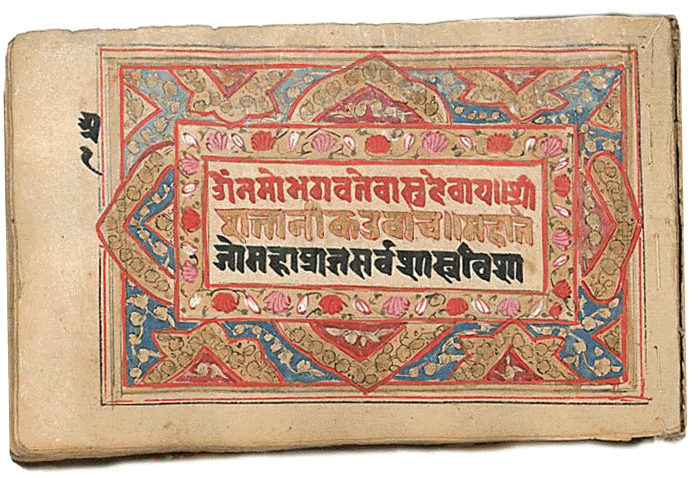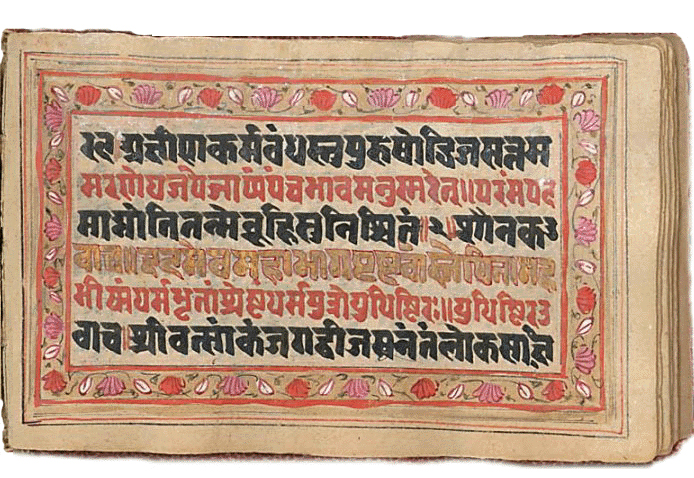Sanskrit
BY: SUN STAFF

Bhagavad-gita Manuscript, Kashmir
Jan 14, CANADA (SUN) — A three-part summary of the history and application of the Sanskrit language.
Sanskrit is the oldest and richest language in the world, and recorded history shows the study of Sanskrit has continued for over five thousand years. The oldest known form of this language is found in the Rgveda. In Vedic culture, the language was used in the public domain and was called bhasa. It later passed through a process of reform or purification, it became known as Sangskrta (Sam -kr + ta).
There are two stages of Sanskrit from the chronological point of view -- Vedic and later Vedic (or Laukika). The later Vedic language is also called Classical Sanskrit. The main difference between these two languages is in their instinctive accents. In Vedic vowel sound there are three kinds of pronunciation -- udatta (high), anudatta (low) and svarita (mixed) -- but in Sanskrit this distinction is not maintained.
Panini's Astadhyayi is the main Sanskrit grammar book. In a later period, Astadhyayi became even more authoritative through the contributions of Vartikakara Vararuchi (or Katyayana) and Bhasyakara (the commentator) Patanjali. So the complete Astadhyayi is called Trimunivyakarana (contribution of three grammarians). The rules, which have been compiled in Astadhyai, are considered to be essential for Sanskrit language and literature. Besides Astadhyai there are many other famous grammars in Sanskrit. Among them Katantravyakarana by Sharvavarman (100 AD), Chandravyakarana by Chandragomin (c 700 AD), Vakyapadiya by Bhartrhari (700 AD), Katantrasutravrtti by Durgasingha (900 AD), Siddhahemachandranushasana by Hemachandra (1050-1100 AD), Mugdhavodhavyakarana by Vopadeva (1200-1250 AD), Jaumaravyakarana by Kramadishvara (1200-1250), Saupadmavyakarana by Padmanabha Datta (1300-1350), Harinamamrta by Rupagosvami, (c 1470-1559), and Siddhantakaumudi by Bhattojidiksita (1700 AD) are worth mentioning.
According to academics, Sanskrit is a language in the Indo-European family of languages. It belongs to a sub-branch of Indo-Iranian. From the philological and geographical point of view, Indo-European languages are divided into two groups Satam and Kentum. Sanskrit falls under the Satam group. It has some startling similarities with Greek and Latin. For this reason, academics believe that these languages originated in the same place and they are thus known as basic Aryan or basic Indo-European languages.
Sanskrit is also known as an Old Indo-Aryan language. The Aryan language is divided into three stages: Old Indo-Aryan Vedic and Sanskrit; Middle Indo-Aryan Pali, Prakrta and Apabhrangsha, and New Indo-Aryan languages like Bangla, Odia, Hindi, Marathi, etc.
The Sanskrit language has no particular alphabet. Wherever the language studied, the alphabet of that area is adopted for it. But the Nagari or Devanagari alphabet is widely used and internationally accepted for Sanskrit.
Sanskrit is an inflectional language. In this language the role of case-ending, and of suffix and prefix is very significant. A word used in a sentence with an inflection is called pada. A word without inflection cannot be used in a sentence. For this reason, the change of the position of a pada in a sentence does not alter the meaning, and for this reason there is no rigid rule for the positioning of a word in sentence constructions.
There are three genders in Sanskrit (masculine, feminine and neuter) and are three numbers (singular, dual and plural). In the verb form there is no change of gender but it has three numbers and three persons (third, second and first). To indicate the tense and mood (including past, present and future tense), there are ten classes of verbal forms. In brief these are known as ten la-karas. The roots are divided into three groups: parasmaipada, atmanepada and ubhayapada. Sanskrit is an ornate language and numerous metres are seen in Sanskrit verse.
Initially, the geographical area of Sanskritic studies was confined to the northern part of India and then it extended to western and eastern India. Gradually its use spread among the neighbouring Dravid, Austric and Sino-Tibetan peoples. Its influence also spread to the neighbouring countries, e.g., China and Tibet. Sumatra, Borneo, and even to neighbouring Western countries. Sanskrit is related inseparably to ancient Indian religion, philosophy, literature and culture. A knowledge of Sanskrit is very essential for analysing the structural nature of the language of the region and for searching the origins of new Indo-Aryan languages.
At present the study of Sanskrit is mostly confined to India. In Bangladesh, Sanskrit has been studied from the ancient period, though at present its study is limited to a few areas. In many schools and colleges under the Board of Dhaka, Chittagong, Barisal, Jessore Sanskrit language and literature are studied. In the University of Dhaka, Chittagong and Rajshahi, Sanskrit is studied in BA (Hons), MA, MPhil and PhD courses. In the National University too there is provision for study of Sanskrit in BA and MA classes. Moreover, in various tols and chatuspathis under the Sanskrit and Pali education board, Sanskrit is studied according to the traditional system. In this Board there is provision of examination in Adya, Madhya and Upadhi in different branches of Sanskrit.

Bhagavad-gita Manuscript, Kashmir
Sanskrit Literature
All branches of literature including poetry, prose and drama are to be found in Sanskrit. Innumerable books have been written in Sanskrit on different subjects, including philology, comparative grammar, philosophy, rhetoric, logic, physiology, astronomy, astrology, chemistry, algebra, geometry, medical science, zoology, social welfare, sexology, etc.
Sanskrit texts can be divided into literature, philosophy, tantra, scriptures, science, etc. The ancient books of the Hindu religion were written in Sanskrit. Sanskrit literature can be divided into four stages: Vedic, epic, puranic and classical. Vedic literature is divided into Sanghita (rk, saman, yajus and atharvan), Brahmana, Aranyaka and Upanisad. The Brahmana, relating to sacrifices or rituals, is called karmakanda, and the Upanisad is called the jnanakanda (philosophical part) of the Vedas.
vIn the Vedic period a kind of literature was written in the form of aphorism (sutra) and was known as sutra-literature. It is divided into four parts: Shrauta, Grhya, Dharma and Shulvasutra. The rules of Shrauta sacrifice were written in Shrautasutra. The subject matter of Grhyasutra is the sacrificial rites to be followed by householders. The commandments and prohibitions relating to religion and secular affairs, the rules about the four castes (chaturvarna) and four stages of life (chaturashrama) were written in Dharmasutra. The rules regarding the measurement of land at the time of making sacrifices in altars are to be found in Shulvasutra. Sutra-literature is considered as a source book for acquiring knowledge about ancient Indian civilization and social life.
There are six Vedangas that have been written for the convenience of the study of the Vedas; these are Shiksa, Kalpa, Nirukta, Vyakarana, Chhandas and Jyotisa. Shiksa is actually on phonetics. The subject matter of Shiksa is varna, svara, matra, vala, sama, Santana, etc. Every Veda has its unique Shiksa. Kalpa is sutra literature; because sacrificial rites are confirmed through it, its name is kalpa. Nirukta was composed by Yaska (c. 600 BC). T
The words of the Vedas are collected and explained in Nirukta. Vyakarana is a very essential Vedanga. The Vyakaranarnava of Vyasadeva and the Maheshavyakarana of Maheshvara are known to be very ancient grammar texts, but none of them have been found. For the reading of metrical Vedic hymns, Chhanda is essential. Vedic hymns are composed in syllabic meters; they are not like the gana-chhandas of Sanskrit. There are seven metres in the Veda Gayatri, usnik, anustup, vrhati, pankti, jagati and tristubh. The jyotisa was created for learning about the planets and stars, etc., to determine the time of sacrifice. Vrhaddevata and Anukramani are also worth knowing. The gods and goddesses of the Rgveda are discussed in the Vrhaddevata of Shaunaka and the rsi, chandas, devata and viniyoga related to Vedic hymns are discussed in Anukramani.
The Ramayana and the Mahabharata were composed in the epic period. In these two vast epics, the essence of India is reflected. Valmiki is the writer of the Ramayana, and he was believed to be the first creator of worldly metre, and the first poet. In his Ramayana, written in anustup metre, Valmiki wanted to celebrate the glorious deeds of the ideal man, who is Lord Ramachandra. There are seven kandas in the Ramayana glorifying Lord Rama's pastimes.
The Mahabharata is massive in its size and scope. Krsna-dvaipayana Vedavyasa composed the Mahabharata in eighteen parvas (chapter) about the war between the Kauravas and Pandavas. In course of time, compositions of many unknown poets were added to it. More than one lakh verses can be found in the present Mahabharata. The Bhagavad-gita falls under the Bhismaparva of Mahabharata. The Gita, composed in eighteen chapters, is recognized as an independent and excellent book, where Lord Krsna instructs Arjuan in gaining perfection in life through Bhakti yoga.
Puranic literature is very vast. Eighteen mahapuranas and eighteen upa-puranas are considered as the main puranas. The Puranas were composed in different times, but Vyasa is known as the only composer of the Puranas, regardless. Mahapuranas have been classified according to the supremacy of three gods: Lord Brahma, Visnu and Shiva. The subject matter of the Puranas includes the creation, existence, destruction, and regeneration of the universe; the stories of the Manus, gods, kings and dynasties, etc. are also discussed. In addition, philosophy, scriptures, rhetorics, etc. are also included in the Puranas as subjects. To know the political and social history of ancient India, the Puranas are indispensable.
Classical Sanskrit is mainly divided into two parts: drshyakavya and shravyakavya. Dramatic literature is under drshyakavya and prose-poetry is under shravyakavya. The greatest poet of this period is Kalidasa (100 BC). His predecessor was the famous dramatist Bhasa (500-400 BC) and Shudraka (300 BC) and a successor poet was Ashvaghosa (100 AD). Bhasa wrote thirteen plays including Svapnavasavadatta, Charudatta, Urubhanga. The plays of Bhasa are celebrated for the diversity of their themes and techniques, and are written based on the Ramayana, the Mahabharata and folktales. Shudraka's Mrchchhakatika is very remarkable in Sanskrit dramatic literature.
The main works of Kalidasa are two mahakavyas, Raghuvangsha and Kumarasambhava; two khandakavyas - Rtusanghara and Meghaduta; three plays - Malavikagnimitra, Vikramorvashiya and Abhijnanashakuntala.
The important works of Ashvaghosa are Buddhacharita and Saundarananda, the two mahakavyas and the play Shariputraprakarana.
Among subsequent works, mention may be made of the Kundamala of Dinnaga (500 AD), Kiratarjuniya of Bharavi (600 AD), Bhattikavya or Ravanavadha of Bhatti (600 AD), Shishupalavadha of Magha (700 AD); Ratnavali of Shriharsa (700 AD); Uttararamacharita of Bhavabhuti (700/800 AD); Venisanghara of Bhattanarayana (800 AD), Mudraraksasa of Vishakhadatta (800/900 AD), Balaramayana of Rajashekhara (1000 AD); Gita-govinda of Jayadeva (1200 AD), Naisadhacharita of Shriharsa (1200 AD), Pravodhachandrodaya of Krsnamishra (1100 AD), Chaitanyachandrodaya and Chaitanya-caritamrta of Kavi-karnapura (1600 AD)
Some noteworthy mahakavyas based on history are the Navasahasankacharita of Padmagupta (1100 AD), Vikramankadevacarita of Vihlana (1100-1200 AD), Kumarapalacarita of Hemachandra (1080-1173 AD), Rajatarangini of Kahlana (1200 AD), and ramacharitam of Sandhyakar Nandi (1200-1300 AD). Following the instructions of Sri Caitanya Mahaprabhu, Srila Rupa Goswami and Srila Jiva Goswami have also contributed a great many nectarian texts to Sanskrit literature.
Source: Compiled by Narayan Chandra Biswas for Banglapedia
